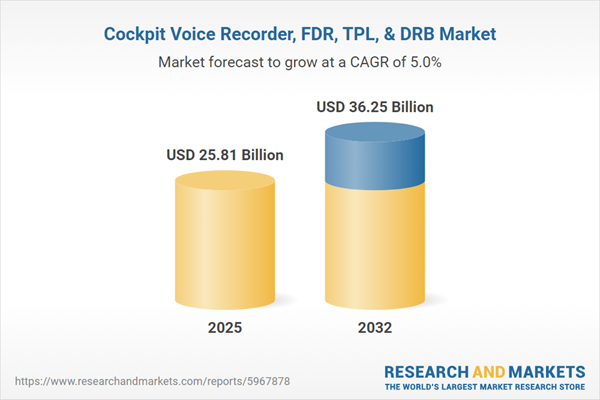Speak directly to the analyst to clarify any post sales queries you may have.
Flight data recorder technology is elevating operational standards and reshaping aviation safety priorities for senior decision-makers, as organizations worldwide seek to strengthen data governance and remain agile amid shifting regulatory requirements.
Market Snapshot: Flight Data Recorder Market Size and Growth
The global flight data recorder market is experiencing steady expansion, with projections indicating a valuation of USD 36.25 billion by 2032 and a compound annual growth rate (CAGR) of 4.97%.
Driving forces include accelerated adoption of digital storage, compliance-driven procurement trends, and increased demand for robust system performance. Both civil and military aviation sectors are revising protocols and modernizing systems to align with evolving international standards, placing renewed emphasis on lifecycle management and maximizing fleet uptime using advanced data capture solutions.Scope & Segmentation of the Flight Data Recorder Market
This report empowers senior executives to enhance procurement, operational strategies, and compliance frameworks, focusing on the most influential segments and emerging technologies:
- Product Types: Cockpit voice recorders, flight data recorders, data recording boxes, and thermal protective locator beacons are vital to rigorous record-keeping, supporting both incident investigation and regulatory adherence for commercial and defense aviation.
- Platforms: Commercial aircraft, defense, and general aviation segments each face distinct integration and regulatory challenges that shape their investment and technical deployment priorities.
- Installation Models: Aftermarket retrofits, OEM block modification, and OEM line fit pathways offer organizations adaptable upgrade routes, minimizing disruption to fleet operations during deployment of new data recording systems.
- End Uses: Airlines, defense operators, and MRO providers evaluate solutions by safety, compliance, and asset optimization needs, considering unique requirements based on fleet size and operational complexity.
- Technologies: Magnetic tape recorders and advanced solid-state recorders, leveraging NAND and NOR flash technologies, drive improved data protection, diagnostic accuracy, and operational reliability across global fleets.
- Regions Covered: Americas, EMEA, and Asia-Pacific each demonstrate varied technology adoption rates and regulatory frameworks, prompting organizations to tailor sourcing and partnership strategies to achieve consistent compliance.
- Featured Companies: Honeywell International Inc., RTX Corporation, L3Harris Technologies, Safran S.A., Thales S.A., AMETEK Inc., Curtiss-Wright Corporation, Cobham plc, TransDigm Group Incorporated, and Garmin Ltd. are recognized for establishing benchmarks in compliance and technical innovation.
Key Takeaways: Strategic Insights for Airlines and Operators
- Analytics and machine learning integration is shifting maintenance scheduling from reactive to proactive, advancing operational reliability and supporting targeted risk mitigation.
- Adoption of modern solid-state flight data recorders is streamlining audit trails, bolstering data integrity, and facilitating nimble responses to dynamic regulatory standards.
- Collaboration among leading manufacturers is enabling greater regulatory harmonization and transparency throughout the aviation supply chain, raising standards across international operations.
- Enhanced data security, including encrypted storage and real-time data transmission, helps organizations address new privacy expectations while maintaining trust in digital exchanges.
- Geographically differentiated fleet modernization and MRO initiatives are shaping supplier relationships, ensuring that flight data management strategies align closely with regional compliance drivers and operational demands.
- Flexible procurement strategies, such as embracing nearshoring, are strengthening supply chain resilience and supporting consistent adherence to evolving industry and regulatory landscapes.
Tariff Impact on Flight Data Recorder Technology Supply Chains
Recent U.S. tariffs have contributed to component cost increases, impelling airlines, OEMs, and MRO providers to diversify supplier bases and expedite nearshoring initiatives. These adaptive approaches are reinforcing the resilience of aviation equipment supply chains and supporting continued regulatory compliance as global standards evolve.
Methodology & Data Sources
This analysis draws from interviews with executives within airlines, defense agencies, MRO organizations, and avionics integrators. Additional insights are provided by whitepapers, industry journals, regulatory studies, and comprehensive patent evaluations, building a robust and balanced market outlook.
Why This Report Matters
- Equips technology, procurement, and compliance leaders to recognize new opportunities and adapt flight data recording solutions to rapidly evolving operational requirements.
- Delivers actionable guidance for developing robust partnerships, reinforcing supply chain integrity, and advancing organizational transformation through technology selection and compliance alignment.
- Links executive priorities across regulatory frameworks and operational performance, enabling stakeholders to focus on sustainable compliance and competitive positioning.
Conclusion
Senior decision-makers can leverage this report for essential insights and data-driven strategies, supporting streamlined operations and long-term competitiveness as flight data recording technologies advance.
Additional Product Information:
- Purchase of this report includes 1 year online access with quarterly updates.
- This report can be updated on request. Please contact our Customer Experience team using the Ask a Question widget on our website.
Table of Contents
3. Executive Summary
4. Market Overview
7. Cumulative Impact of Artificial Intelligence 2025
Companies Mentioned
The companies profiled in this Cockpit Voice Recorder, FDR, TPL, & DRB market report include:- Honeywell International Inc.
- RTX Corporation
- L3Harris Technologies, Inc.
- Safran S.A.
- Thales S.A.
- AMETEK, Inc.
- Curtiss-Wright Corporation
- Cobham plc
- TransDigm Group Incorporated
- Garmin Ltd.
Table Information
| Report Attribute | Details |
|---|---|
| No. of Pages | 199 |
| Published | October 2025 |
| Forecast Period | 2025 - 2032 |
| Estimated Market Value ( USD | $ 25.81 Billion |
| Forecasted Market Value ( USD | $ 36.25 Billion |
| Compound Annual Growth Rate | 4.9% |
| Regions Covered | Global |
| No. of Companies Mentioned | 11 |









